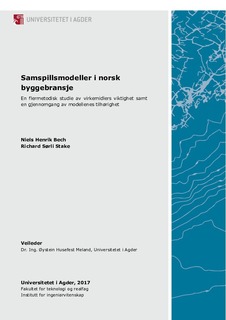| dc.description.abstract | In an international perspective, the literature shows the construction industry to be highly
prone to conflict, as well as highlighting the potential for improvement of productivity and
efficiency. Today there exists several different project delivery and contracting strategies
(PDCS) within the construction industry, and they each have their benefits and drawbacks. A
certain type of models that has gained traction in the recent years is collaboration models
(CMs). These PDCS’s build upon relational aspects to a great extent, and are thought to
counteract some of the conflicts and problems following more traditional PDCS’s.
Not a lot of research is previously done on CMs in Norway. The reason for this has to do with
this type of PDCS only playing a small part in the Norwegian construction industry since its
introduction in the mid-1990s. As such, the purpose of this thesis has been twofold. The first
was to study the lack of a definition of CMs in a Norwegian context, and subsequently where
they belong. This was done through literature, document study and interviews.
Placing this model has shown to be a great challenge. Norwegian published literature on the
topic shows a lack of consistency. Much of the literature rely on the English term
«partnering» when they compare to «the Norwegian collaboration models», others look to
alliancing, and some mix these. The problem is further increased by the lack of a definition
regarding traditional PDCS’s. In an attempt to create a unified understanding and agreement,
this study makes an attempt to place CMs within the frames of traditional PDCS’s.
This thesis has chosen partnering as a basis, but as the report shows, CMs are a lot more than
solely partnering. The authors of this study consider CMs in Norway to have become a type
of PDCS’s in its own, drawing from both partnering and alliancing as well as other relational
PDCS’s. Instead of defining CMs in a rigid manner, CM-elements are divided into five
categories. This is thought to contribute to a greater understanding of the concept, and at the
same time changes can easily be implemented following changes within the industry. For
these reasons, a proposal for an alternative approach to CMs in Norway have been developed.
The other purpose was to map the importance of elements comprising CMs. The intention
was to map the importance of elements as seen by the industry itself, considering the project parameters time, quality and life cycle cost. To best be able to assess relevant elements, a
preliminary study was deemed necessary.
Access to the project Lyngdal Helsehus, which is executed using the PDCS
Lyngdalsmodellen, was given through Rambøll. Lyngdalsmodellen is a specific type of CM.
In relation to this project, a document study and an observational study, as well as interviews,
was conducted. A literature study on relational PDCS’s, with a main focus on partnering
models, was conducted in parallel to this.
The preliminary study gave the authors an increased understanding of CMs. A questionnaire
was designed based on the preliminary studies, and was aimed at key project participants who
had experience from one or more projects carried out using this type of PDCS’s in Norway.
The study was completed by 108 respondents in the target group, from all major parts of
Norway. Even though the study was carried out using a non-probabilistic sampling method
and should not be generalized, it can be argued that the study is representative. This is based
on the large number of respondents as well as the spread among organizations, roles and
locations.
The participants have rated commitment, communication, contract form, mutual goals and the
right people, in this order, as the five most important elements for achieving a successful CMproject.
These results are presented in an overall ranking of the total importance of the
elements. Furthermore, it was shown that elements based on interpersonal relations was
considered important. Somewhat surprising was it to find that the inclusion of different
groups, such as subcontractors and architects, in bonus/malus generally was considered of low
importance.
Furthermore, it worked as an operationalization of the elements, which made it possible to
decompose the elements. The study concludes that the overall ranking represents the opinion
within the industry. Among the respondents of the questionnaire, 93 % considered that
increased use of CMs was the direction the industry should pursue. From these results, it
seems like such projects are becoming an increasing trend, and that this study can become an
important contribution to further work within CMs. | nb_NO |

